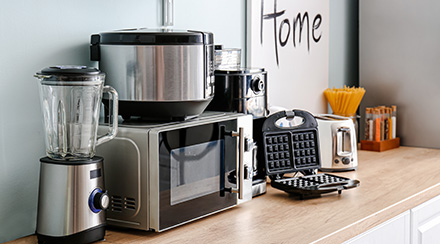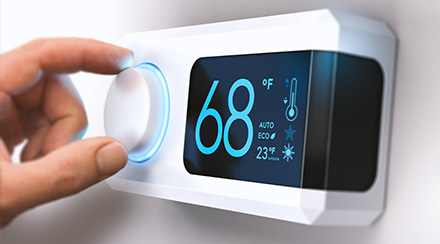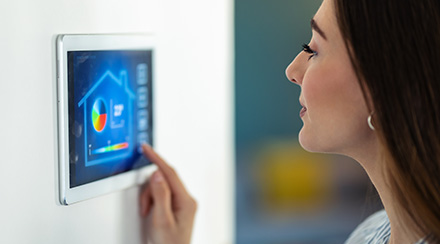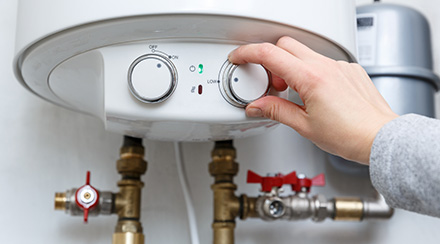What Uses the Most Electricity In a Home?

It takes a lot of appliances and electronics to make a modern home feel like home, and some of that equipment uses a lot more energy than others. Have you ever wondered what uses the most electricity in a home? We’re breaking it down to give you a better understanding of where your energy dollars are going, and where you can save the most by using energy more efficiently.
Household Energy Consumption Averages
No two households are exactly alike, but on average, just over half of a typical household’s energy consumption comes from heating and air conditioning, according to the U.S. Energy Information Administration (EIA). Heating accounts for 43% on average, and air conditioning accounts for another 8%. Keep in mind that these figures will vary based on climate, and that they include non-electrical energy, like natural gas heating.
Water heating accounts for another 19%, followed by 5% for lighting, 3% for refrigeration and 21% for everything else – TVs, computers, washers, dryers, countertop appliances, etc.
Let’s take a look at each of these categories in greater detail.
What Appliances Use the Most Electricity?
Space Heating
Furnaces don’t consume as much energy in the warmest climates, but throughout much of the U.S., they account for nearly half of all energy use – sometimes more. Most electric furnaces use between 10,000 and 50,000 kilowatts of electricity – a wide range – and there are a number of other variables that affect their true energy use, including the local climate, thermostat setting, insulation quality and the age and condition of the equipment.
The energy efficiency of furnaces and boilers is measured by annual fuel utilization efficiency (AFUE). The AFUE is the ratio of a heater’s annual heat output to its annual energy consumption. The higher the AFUE, the more efficient the system.
When shopping for a new furnace, pay attention to the AFUE, as well as the black and yellow EnergyGuide label, which includes estimates of the system’s annual energy consumption and operating cost. You should also keep an eye out for the ENERGY STAR logo, which denotes appliances that meet the highest energy efficiency standards.
Once you have an energy-efficient furnace installed, keeping your heater energy use low comes down to home maintenance and smart habits:
- Make sure your wall and attic insulation is sufficient for your climate zone
- Change air filters on schedule
- Replace cracked weather stripping around windows and doors
- Seal leaks in ductwork
- Allow free airflow around vents
- Schedule an annual furnace tune-up
- Spin ceiling fans clockwise at low speed to redistribute warm air
- Dress warmly and keep the thermostat as low as comfortably possible
Air Conditioning
Just like furnaces, air conditioning energy consumption is subject to the same variables. An EIA study found that air conditioning accounts for an average of 27% of energy use in hot and humid climates, but only 2% in marine climates like the coast of the Pacific Northwest, with varying levels of energy use in more temperate climates.
Air conditioner efficiency is measured by the seasonal energy efficiency ratio, or SEER. SEER is the product of an air conditioner’s cooling output divided by its power consumption. And just as it is with AFUE, the higher the SEER rating of an air conditioner, the more efficient it is. The EnergyGuide labels and ENERGY STAR logos are also important to pay attention to when shopping for a new, energy-efficient air conditioner.
The same maintenance tips that apply to heating systems also apply to air conditioners. Upgrading insulation, changing filters regularly, replacing weather stripping and sealing leaky ducts will all help with your A/C efficiency. Just like furnaces, air conditioners should be tuned up every year by a licensed professional. And to stretch your home cooling dollar, you should dress lightly and spin ceiling fans counterclockwise so you can comfortably set the thermostat a few degrees higher. Additionally, a smart thermostat is a smart upgrade that can give you an easy efficiency boost in your heating and cooling equipment.
Water Heating
According to the EIA’s study, water heating uses more than twice as much energy on average as air conditioning, but there are plenty of variables that affect this as well. Gas water heaters tend to be slightly more efficient than electric water heaters, and tankless water heaters are much more efficient than traditional tank units. The unit’s age, size and thermostat setting all affect energy consumption, as well as the amount of hot water used.
Like furnaces and air conditioners, water heaters have their own efficiency rating system. The uniform energy factor (UEF) is the unit’s heating output divided by its energy consumption, so the higher the UEF, the more efficient the unit. EnergyGuide labels and ENERGY STAR logos are helpful here as well.
To save on water heating costs, try these tips:
- Keep the thermostat between 120 and 140 degrees Fahrenheit – 120 is safe and comfortable enough for most applications, but you may want to set it as high as 140 to completely eliminate the risk of bacteria
- Take shorter showers, and consider upgrading to a water-saving showerhead
- Cover your traditional tank water heater with an insulating jacket
- Run full loads in your dishwasher, and favor your dishwasher over hand-washing when possible
- When replacing your water heater, buy the smallest capacity that will work for your household and place an emphasis on energy-efficient models

Lighting
The potential to save big on household lighting has come a long way with the introduction of LED bulbs. According to the Department of Energy, LEDs use at least 75% less energy than old-fashioned incandescent bulbs, and last up to 25 times longer. LEDs also give off far less heat, which can help with air conditioner efficiency in the summer.
Upgrading all of your light bulbs to LEDs is the biggest change you can make to save energy on lighting. But to save even more, make a habit of turning off lights in empty rooms or when they’re not in use. If you have trouble remembering, you can also install motion detectors for some lighting, or upgrade to smart LED bulbs that can be controlled from anywhere with a smartphone.
Refrigeration
The energy consumption of refrigerators can vary quite a bit from one model to the next, but the EIA report above shows an average energy use share of 3% for refrigeration – a small slice of the pie, but still a substantial amount for a single appliance. Because refrigerators lose efficiency over time and the appliance industry is always finding new ways to improve efficiency, the age of your refrigerator is one of the biggest factors in its energy use. Refrigerators generally last 10 to 15 years, and if you continue to use a refrigerator long past its prime, it could really start to cost you.
As with other major appliances, the EnergyGuide label and ENERGY STAR logos can help guide your buying decisions. But there are other things you can do to save more on refrigeration at home:
- Periodically clean your refrigerator inside and out, taking care to remove dust from the vents and coils on the back of the refrigerator and underneath
- Keep the refrigerator temperature set to around 37 degrees Fahrenheit, and the freezer around 0 degrees
- Check the rubber gaskets around the refrigerator and freezer doors, and if you find them to be cracked or leaking, repair or replace them
- If possible, place your refrigerator far away from your oven or other heat-producing appliances
- Keep your refrigerator and freezer full, but not too full – make sure there’s room for air circulation
- Allow leftovers to cool completely before putting them in the refrigerator
Everything Else
Most other common appliances and electronics use less energy on their own than any of the categories outlined above. The appliances that use the most energy tend to be the ones that generate heat, such as clothes dryers, dishwashers and countertop cooking appliances, but we don’t use these as frequently as furnaces or water heaters.
It helps to pay attention to energy efficiency information when shopping for new appliances and electronics, but since these other devices use less energy overall, your potential savings will be smaller. Still, there are more things you can do to keep your total energy use as low as possible:
- Use energy-saving and auto shut-off settings on electronics like TVs and computers
- Hang-dry laundry when possible, and be sure to stop your dryer cycle as soon as clothes are dry
- Air-dry or hand-dry the dishes in your dishwasher rather than using the heat-dry setting
- Use power strips to easily disconnect groups of electronics and chargers with the touch of a button
Understanding how your household energy use breaks down is key to making smart, energy-saving decisions. Start with your home’s biggest energy users and make a few changes today to save money and help the environment.
Looking for Something Specific?
Select a category to find resources for topics that interest you.
Select Category

Related Articles:

Tips for Improving Your AC and Furnace Efficiency
We share maintenance tips for your heater and AC, and home improvement tips to help you use those systems less.
Read Article
Tips for Saving on Energy in Your Home
If you’re looking to learn more about energy efficiency for home systems and appliances, we’re sharing our favorite energy-saving tips.
Read Article
Water Heater Energy Efficiency Explained
Unless you like taking cold showers, water heating is probably not something you can live without. But did you know that your water heater is one of the biggest energy-consuming appliances in your home?
Read ArticleWhat Uses the Most Electricity In a Home?
It takes a lot of appliances and electronics to make a modern home feel like home, and some of that equipment uses a lot more energy than others. Have you ever wondered what uses the most electricity in a home? We’re breaking it down to give you a better understanding of where your energy dollars are going, and where you can save the most by using energy more efficiently.
Household Energy Consumption Averages
No two households are exactly alike, but on average, just over half of a typical household’s energy consumption comes from heating and air conditioning, according to the U.S. Energy Information Administration (EIA). Heating accounts for 43% on average, and air conditioning accounts for another 8%. Keep in mind that these figures will vary based on climate, and that they include non-electrical energy, like natural gas heating.
Water heating accounts for another 19%, followed by 5% for lighting, 3% for refrigeration and 21% for everything else – TVs, computers, washers, dryers, countertop appliances, etc.
Let’s take a look at each of these categories in greater detail.
What Appliances Use the Most Electricity?
Space Heating
Furnaces don’t consume as much energy in the warmest climates, but throughout much of the U.S., they account for nearly half of all energy use – sometimes more. Most electric furnaces use between 10,000 and 50,000 kilowatts of electricity – a wide range – and there are a number of other variables that affect their true energy use, including the local climate, thermostat setting, insulation quality and the age and condition of the equipment.
The energy efficiency of furnaces and boilers is measured by annual fuel utilization efficiency (AFUE). The AFUE is the ratio of a heater’s annual heat output to its annual energy consumption. The higher the AFUE, the more efficient the system.
When shopping for a new furnace, pay attention to the AFUE, as well as the black and yellow EnergyGuide label, which includes estimates of the system’s annual energy consumption and operating cost. You should also keep an eye out for the ENERGY STAR logo, which denotes appliances that meet the highest energy efficiency standards.
Once you have an energy-efficient furnace installed, keeping your heater energy use low comes down to home maintenance and smart habits:
- Make sure your wall and attic insulation is sufficient for your climate zone
- Change air filters on schedule
- Replace cracked weather stripping around windows and doors
- Seal leaks in ductwork
- Allow free airflow around vents
- Schedule an annual furnace tune-up
- Spin ceiling fans clockwise at low speed to redistribute warm air
- Dress warmly and keep the thermostat as low as comfortably possible
Air Conditioning
Just like furnaces, air conditioning energy consumption is subject to the same variables. An EIA study found that air conditioning accounts for an average of 27% of energy use in hot and humid climates, but only 2% in marine climates like the coast of the Pacific Northwest, with varying levels of energy use in more temperate climates.
Air conditioner efficiency is measured by the seasonal energy efficiency ratio, or SEER. SEER is the product of an air conditioner’s cooling output divided by its power consumption. And just as it is with AFUE, the higher the SEER rating of an air conditioner, the more efficient it is. The EnergyGuide labels and ENERGY STAR logos are also important to pay attention to when shopping for a new, energy-efficient air conditioner.
The same maintenance tips that apply to heating systems also apply to air conditioners. Upgrading insulation, changing filters regularly, replacing weather stripping and sealing leaky ducts will all help with your A/C efficiency. Just like furnaces, air conditioners should be tuned up every year by a licensed professional. And to stretch your home cooling dollar, you should dress lightly and spin ceiling fans counterclockwise so you can comfortably set the thermostat a few degrees higher. Additionally, a smart thermostat is a smart upgrade that can give you an easy efficiency boost in your heating and cooling equipment.
Water Heating
According to the EIA’s study, water heating uses more than twice as much energy on average as air conditioning, but there are plenty of variables that affect this as well. Gas water heaters tend to be slightly more efficient than electric water heaters, and tankless water heaters are much more efficient than traditional tank units. The unit’s age, size and thermostat setting all affect energy consumption, as well as the amount of hot water used.
Like furnaces and air conditioners, water heaters have their own efficiency rating system. The uniform energy factor (UEF) is the unit’s heating output divided by its energy consumption, so the higher the UEF, the more efficient the unit. EnergyGuide labels and ENERGY STAR logos are helpful here as well.
To save on water heating costs, try these tips:
- Keep the thermostat between 120 and 140 degrees Fahrenheit – 120 is safe and comfortable enough for most applications, but you may want to set it as high as 140 to completely eliminate the risk of bacteria
- Take shorter showers, and consider upgrading to a water-saving showerhead
- Cover your traditional tank water heater with an insulating jacket
- Run full loads in your dishwasher, and favor your dishwasher over hand-washing when possible
- When replacing your water heater, buy the smallest capacity that will work for your household and place an emphasis on energy-efficient models
Lighting
The potential to save big on household lighting has come a long way with the introduction of LED bulbs. According to the Department of Energy, LEDs use at least 75% less energy than old-fashioned incandescent bulbs, and last up to 25 times longer. LEDs also give off far less heat, which can help with air conditioner efficiency in the summer.
Upgrading all of your light bulbs to LEDs is the biggest change you can make to save energy on lighting. But to save even more, make a habit of turning off lights in empty rooms or when they’re not in use. If you have trouble remembering, you can also install motion detectors for some lighting, or upgrade to smart LED bulbs that can be controlled from anywhere with a smartphone.
Refrigeration
The energy consumption of refrigerators can vary quite a bit from one model to the next, but the EIA report above shows an average energy use share of 3% for refrigeration – a small slice of the pie, but still a substantial amount for a single appliance. Because refrigerators lose efficiency over time and the appliance industry is always finding new ways to improve efficiency, the age of your refrigerator is one of the biggest factors in its energy use. Refrigerators generally last 10 to 15 years, and if you continue to use a refrigerator long past its prime, it could really start to cost you.
As with other major appliances, the EnergyGuide label and ENERGY STAR logos can help guide your buying decisions. But there are other things you can do to save more on refrigeration at home:
- Periodically clean your refrigerator inside and out, taking care to remove dust from the vents and coils on the back of the refrigerator and underneath
- Keep the refrigerator temperature set to around 37 degrees Fahrenheit, and the freezer around 0 degrees
- Check the rubber gaskets around the refrigerator and freezer doors, and if you find them to be cracked or leaking, repair or replace them
- If possible, place your refrigerator far away from your oven or other heat-producing appliances
- Keep your refrigerator and freezer full, but not too full – make sure there’s room for air circulation
- Allow leftovers to cool completely before putting them in the refrigerator
Everything Else
Most other common appliances and electronics use less energy on their own than any of the categories outlined above. The appliances that use the most energy tend to be the ones that generate heat, such as clothes dryers, dishwashers and countertop cooking appliances, but we don’t use these as frequently as furnaces or water heaters.
It helps to pay attention to energy efficiency information when shopping for new appliances and electronics, but since these other devices use less energy overall, your potential savings will be smaller. Still, there are more things you can do to keep your total energy use as low as possible:
- Use energy-saving and auto shut-off settings on electronics like TVs and computers
- Hang-dry laundry when possible, and be sure to stop your dryer cycle as soon as clothes are dry
- Air-dry or hand-dry the dishes in your dishwasher rather than using the heat-dry setting
- Use power strips to easily disconnect groups of electronics and chargers with the touch of a button
Understanding how your household energy use breaks down is key to making smart, energy-saving decisions. Start with your home’s biggest energy users and make a few changes today to save money and help the environment.
Looking for Something Specific?
Select a category to find resources for topics that interest you.
Select Category

Related Articles:

Tips for Improving Your AC and Furnace Efficiency
We share maintenance tips for your heater and AC, and home improvement tips to help you use those systems less.
Read Article
Tips for Saving on Energy in Your Home
If you’re looking to learn more about energy efficiency for home systems and appliances, we’re sharing our favorite energy-saving tips.
Read Article
Water Heater Energy Efficiency Explained
Unless you like taking cold showers, water heating is probably not something you can live without. But did you know that your water heater is one of the biggest energy-consuming appliances in your home?
Read Article






